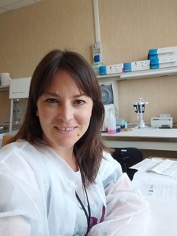
Epithelial stem cells are endowed by impressive regeneration capacities, that sustain epithelia regeneration during homeostasis and wound healing in vivo. In vitro, they can proliferate for dozens of population doublings. Since the 1980s, cultured human keratinocytes have been extensively used to regenerate functional cornea and epidermis. Successful epithelia regenerations require an adequate number of epithelial stem cells, endowed by long lasting proliferative potential and self-renewing capacity. They progressively give rise to transient amplifying progenitors that proceed the onset of terminal differentiation. Despite their clinical success, we still are seeking a clear understanding of the molecular mechanisms that regulate self-renewal and regenerative potential self-renewal and regenerative potential in epithelial stem cells. Taking advantage of single-cell transcriptomic analysis of primary human epithelial cultures we identify the cluster of epithelial stem cells characterized by genes regulating DNA repair, chromosome segregation, spindle organization and telomerase activity. We identify FOXM1 as a YAP-dependent key regulator of epidermal stem cells.
Moreover, we are focusing on how stem cell and transient amplifying progenitors respond to genotoxic insults, looking at specifics molecular mechanisms that allow to prevent accumulation of genetic lesions in epidermal stem cells, and we found that FOXM1 is specifically activated upon genotoxic insults to foster DNA repair process.
A better understanding of the complex network acting to repair the genotoxic insults will be instrumental to improve error-free based gene editing techniques. Moreover, as many genotoxic insults assault skin epithelia eventually causing oncogenic growth, this knowledge will also add insights on skin cancer progression, to develop early diagnostic tools or personalized therapies.
Friday 17/03/2023 12:00 Aula C CU010 Dott. Elena Enzo Centre for Regenerative Medicine ‘‘Stefano Ferrari’’, University of Modena and Reggio Emilia